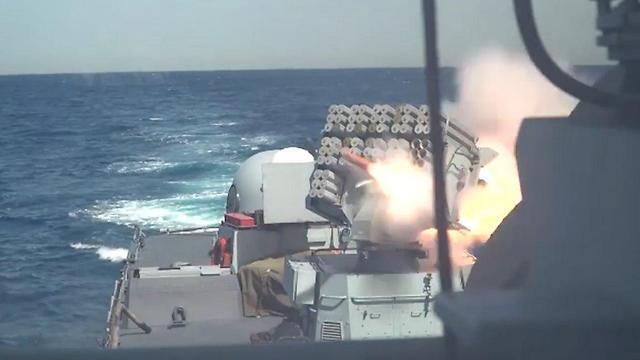Getting your Trinity Audio player ready...
The Israeli Navy's defense systems will soon get an unprecedented upgrade, allowing navy vessels to launch chaff rockets to mislead enemy missiles.
The upgraded system would be able to deal with all kinds of threats—both new and future ones—at sea: From the most advanced anti-ship cruise missiles—such as the Russian P-800 Oniks, also known as Yakhont—to shoulder-fired missiles—including the Russian 9M133 Kornet anti-tank guided missiles, the likes of which have already been fired at ships in the Middle East in recent years.
The system includes an algorithm that identifies and classifies any kind of projectile making its way towards the Israeli missile ship, and then programs a unique diversion plan: chaff rockets are launched from the front deck and create a "wall" over the water of hundreds of metal wires, which mislead the enemy missile into "thinking" this was the Israeli ship. This helps divert the enemy missile, only a minute or two before it was to hit the Israeli ship.
(צילום: שמיר אלבז, דובר צהל)
The new system's advanced fire-control radar will know to classify such projectiles as a threat to the ship out of hundreds of other targets in the ship's immediate surroundings.
The first of the missile ships to receive the upgrade is INS Sufa. After a successful test of the system conducted two months ago off the coast of Haifa, the system is expected to be declared operational in the coming weeks.
"Past threats were relatively simple, and we knew them. The world was analog 20 years ago," a Navy officer in charge of the project told Ynet. "Nowadays, the enemy's munitions are digital, so if someone on the other side of the world makes a small change to the program of a missile that could reach our enemies, we immediately have to make adjustments and updates to our systems."
"When a missile ship goes out to sea, it is limited in the number of munitions it can carry, which is why the classification of the threats must be accurate, so we can effectively use our munitions—both in defense and in offense," he added.
The system will join other defense system already on board the Navy's vessels or expected to be added in the foreseeable future, including a system to disrupt the frequencies of enemy missile radars, a naval version of Iron Dome ,and Barak missiles .
"In fact, we developed a system that can choose how to deal with each threat on its way to us, while it's in the air, in short time periods of a minute or two, and at times even in seconds," the officer said. "In this way, we can be more robust and generic in an effort to improve the 'defense score' by shooting less chaff rockets while reaching maximal neutralization of the threat. This is a dramatic leap forward that will provide us with solutions for the next 20 years."
Another senior naval officer added, "We're prepared for the fact the enemy is incorporating all of the latest technological solutions in the market right now, and the unbearable ease with which a civilian multicopter drone can become a remote-controlled bomb. Iran today doesn't have to develop inertial weapons systems, which could take 20 years, they can just buy technological products on the market."





